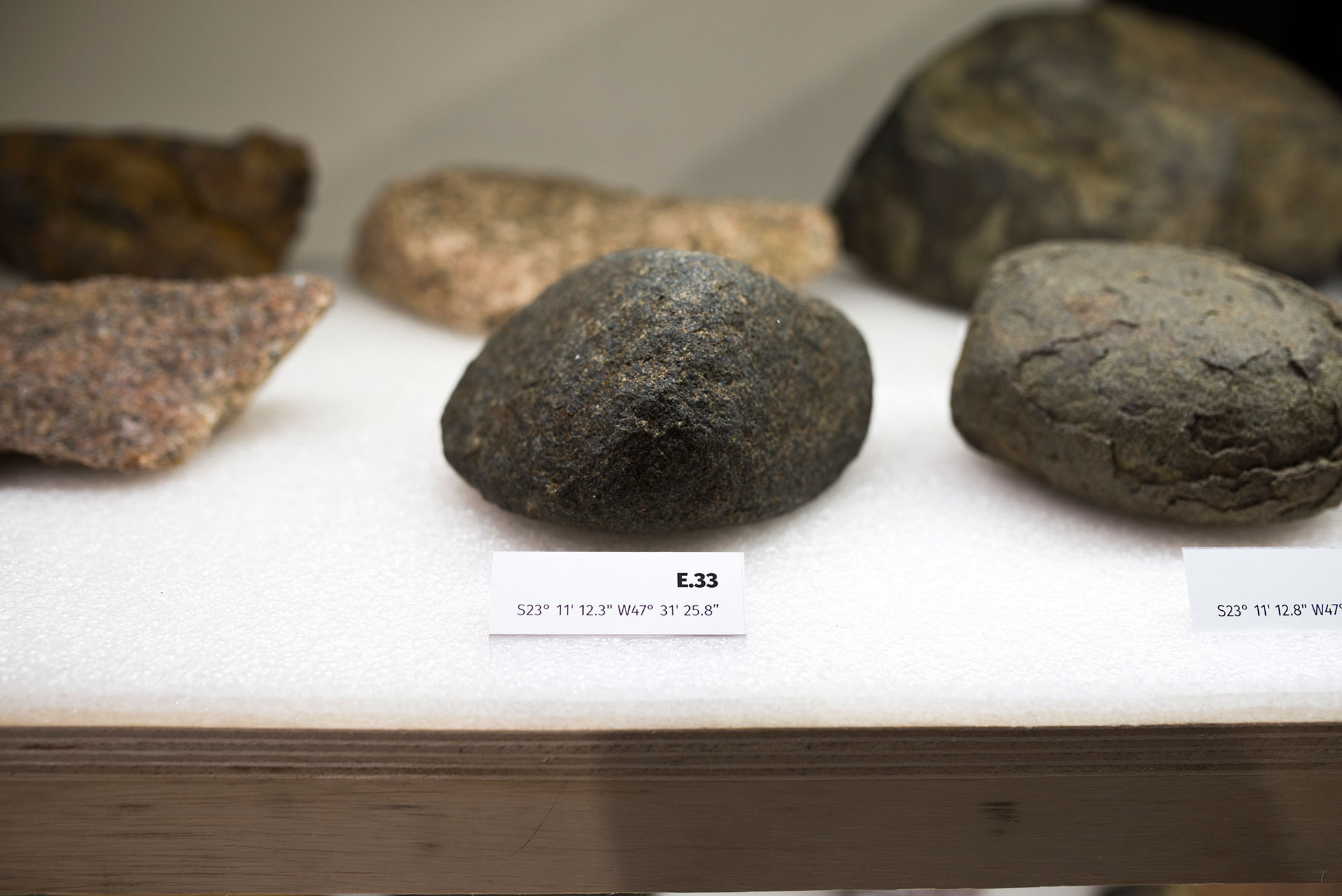Arrasto
[Dragging]
stones, concrete, asphalt, sand, and cobblestone collected from the river banks of Tietê River, wood, polystyrene, laser print on paper, led lamps and graphite drawing on expanded PVC
variable dimensions
2015








In fluid dynamics, it is the drag force that causes resistance to movement of a solid object through a fluid medium as a liquid. The resistance produced from the Tiete River friction with its banks took the artist Marcelo Moscheta to conduct an expedition down all the length of the river from its source in Salesópolis to the mouth of the Paraná River.
From March to August were collected rocks, clays, sands and various minerals on both sides, documented and classified, as well as the Tiete course of cataloging through the elements that are found in its two banks. Flirting with archeology, geology and the Bandeirantismo Paulista cycle, the artist composes a warehouse of particular memories, accounts for a small museum of curiosities that share each, their side of the fluid bed.
The Dragging installation that occupied the central hall of Bandeirante House also joins to collections a large drawing of a waterfall of the Tiete River submerged by the waters of the New Avanhandava dam. Arranged side by side on racks, drawing and rocks create a tensioned dialogue between representation and the landscape itself displaced into the work.
* The Dragging Project was awarded the Funarte Bursary to Stimulate the Production of Visual Arts in 2014 and also has a publication distributed for free on the artist's expedition to the Rio Tietê with texts from Divino Sobral, Douglas de Freitas and the artist himself, as well photos of the expedition and a travel journal.
From March to August were collected rocks, clays, sands and various minerals on both sides, documented and classified, as well as the Tiete course of cataloging through the elements that are found in its two banks. Flirting with archeology, geology and the Bandeirantismo Paulista cycle, the artist composes a warehouse of particular memories, accounts for a small museum of curiosities that share each, their side of the fluid bed.
The Dragging installation that occupied the central hall of Bandeirante House also joins to collections a large drawing of a waterfall of the Tiete River submerged by the waters of the New Avanhandava dam. Arranged side by side on racks, drawing and rocks create a tensioned dialogue between representation and the landscape itself displaced into the work.
* The Dragging Project was awarded the Funarte Bursary to Stimulate the Production of Visual Arts in 2014 and also has a publication distributed for free on the artist's expedition to the Rio Tietê with texts from Divino Sobral, Douglas de Freitas and the artist himself, as well photos of the expedition and a travel journal.









Arrasto
rochas, concreto, asfalto, arenito, areia e paralelepípedo coletados das duas margens do Rio Tietê, madeira, poliestireno, impressão sobre papel, lâmpadas led e desenho a grafite sobre PVC expandido.
dimensões variáveis . 2015
dimensões variáveis . 2015
* O projeto Arrasto foi contemplado com a Bolsa Funarte de Estímulo à Produção em Artes Visuais 2014 e conta ainda com uma publicação com distribuição gratuita sobre a expedição do artista ao Rio Tietê com textos de Divino Sobral, Douglas de Freitas e do próprio artista, além de fotos da produção da instalação e relatos de viagem
Na dinâmica dos fluidos, arrasto é a força que faz resistência ao movimento de um objeto sólido através de um meio fluído, como um líquido. A resistência produzida a partir do atrito do Rio Tietê com suas margens levou o artista Marcelo Moscheta a realizar uma expedição por toda a extensão do rio desde sua nascente em Salesópolis até a foz no Rio Paraná.
De março a agosto foram coletadas rochas, argilas, areias e minerais diversos das duas margens, documentadas e classificadas, assim como uma catalogação do curso do Tietê através dos elementos que são encontrados em suas duas bordas. Flertando com a arqueologia, geologia e o ciclo do Bandeirantismo Paulista, o artista compõe um armazém de memórias particulares, relatos para um pequeno museu de curiosidades que compartilham cada qual, o seu lado do leito fluído.
A instalação Arrasto que ocupou a sala central da Casa do Bandeirante, une ainda um grande desenho de uma queda d’água do Rio Tietê submersa pelas águas da represa de Nova Avanhandava às coletas. Dispostas lado a lado em estantes, desenho e rochas criam um diálogo tensionado entre representação e a própria paisagem deslocada para dentro da obra.